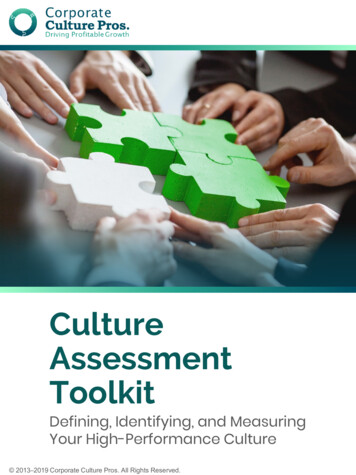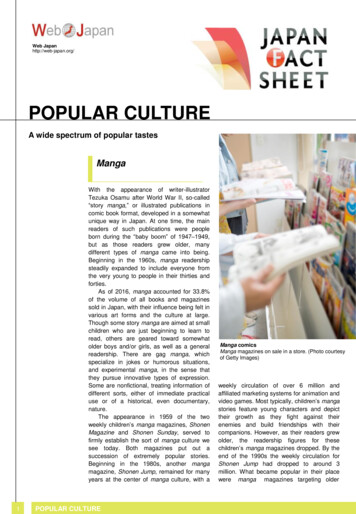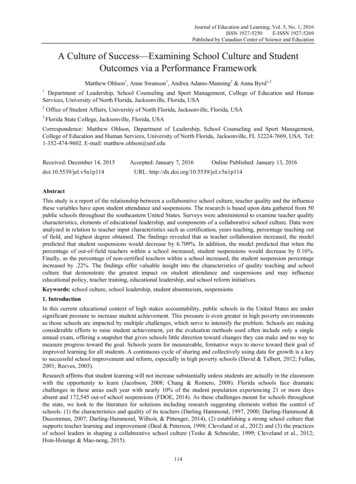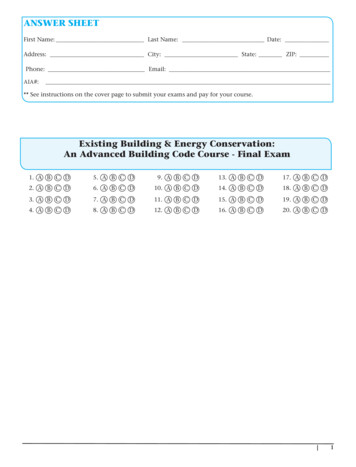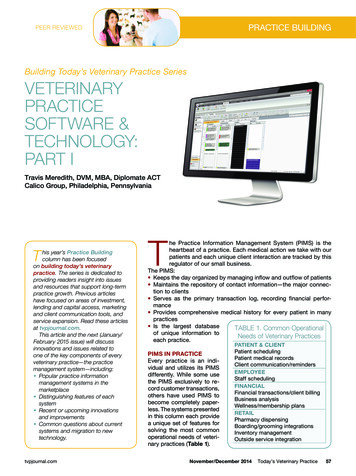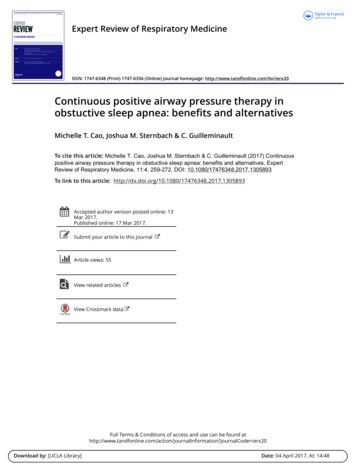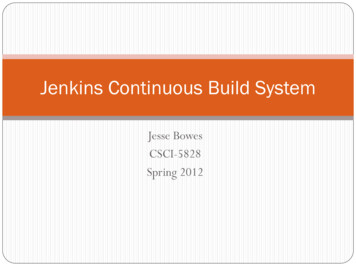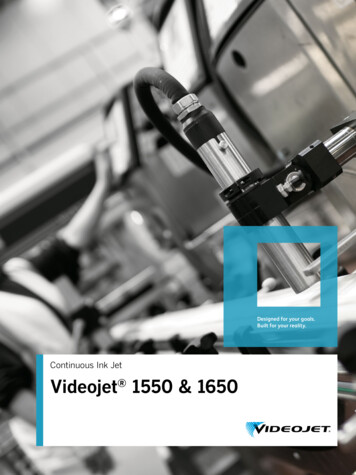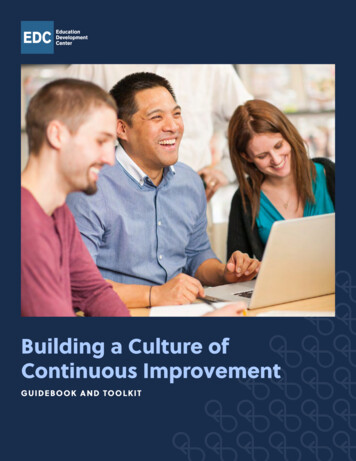
Transcription
Building a Culture ofContinuous ImprovementGU I D EBO O K A N D TOOL K I T
2019 Education Development Center. All Rights Reserved.This work may not be reproduced, sold, or otherwise disseminated without the express written consentof Education Development Center, Inc.
About UsEducation Development Center (EDC) is a globalnonprofit that advances lasting solutions to improveeducation, promote health, and expand economicopportunity. Since 1958, we have been a leader indesigning, implementing, and evaluating innovativeprograms, in collaboration with public and privatepartners. From in-depth research endeavors todistrict- and country-wide reform initiatives, ourprograms provide individuals, families, and communitieswith the knowledge, skills, and support they need toachieve a better future. Education Development CenterThis publication may be shared without charge for educational, charitable,nonprofit or other non-commercial purposes. Such use must includeacknowledgement that it is “with the permission of Education DevelopmentCenter.” All other use is prohibited without the prior written permission of EDC.For permission requests, please contact communications at contact@edc.orgor 617-969-7100.
ForewordAt EDC, we believe in the value of organizational learning and improvement.We have long been committed to supporting schools, districts, state agencies,community organizations, and other partners in designing, implementing,and sustaining effective practices, programs, and policies. To that end, EDCprovides tools, resources, and services to help partners build capacity for aworking culture of collaboration, reflection, inquiry, problem solving, andimprovement toward equitable outcomes. We focus on both the technical andadaptive qualities of systems reform, which we consider to be necessary fortransformational change.This guidebook is designed for learning organizations that are committedto empowering practitioners and leaders to improve conditions in complexeducation systems. The conceptual framework and design of this guidebook isrooted in research and experience. We build on scholarship from implementation science, systems change, continuous improvement, and scale. EDC alsoengaged in an iterative design process and used lessons learned from oureducation partners to inform the final design of this guidebook.We would like to thank the Nellie Mae Education Foundation for supportingour work and giving us an opportunity to develop this resource. We are alsoeternally grateful to educators, administrators, leaders, community partners,and others who provided meaningful feedback throughout the various stagesof development.Eliza FabillarSenior Project DirectorEducation Development CenterApril 2019
ContentsOverview: Principles to Guide Continuous ImprovementIntroductionA. What is Continuous Improvement?B. An Integrated Model for ImprovementC. The Importance of Culture and Human CapitalD. Guiding Principles for Continuous ImprovementTool: Continuous Improvement Organizational Self-Assessment SurveyTool: Building Capacity of Education Professionals for Deep Learning1011111315171717Chapter 1: Build Common Purpose and UnderstandingIntroduction1.1 What is a Theory of Change?1.2 Defining the Goal1.3 Empathize, Analyze, Understand1.4 What is a Problem of Practice?1.5 Developing a Theory of ChangeTool: Driver Diagram2425252728323338Chapter 2: Support System Alignment and ChangeIntroduction2.1 A Human-Centered Systems Change Reflective Process2.2 System Mapping of People, Practices, Programs, and Policies2.3 Strategies for Change Management2.4 Applying Theory to Practice: A Case StudyTool: Systems Alignment TemplateTool: Change Management4041424748535757Chapter 3: Plan for a Cycle and ImplementIntroduction3.1 Identifying a Suite of Change Practices3.2 A Method for Improvement: Plan-Do-Study-Act (PDSA)3.3 Types of Improvement Data and Measures3.4 A Case Study3.5 Complete a Data Collection Plan StudyTool: Plan-Do-Study-Act Template5859606366697273Chapter 4: Study, Reflect, and ActIntroduction4.1 Guidelines for Maintaining a Focus on Equity4.2 Compiling and Organizing Data4.3 Collaborative Data Study4.4 Making Decisions and Actions Based on Lessons Learned4.5 Documenting Your Story: Continuous Improvement Journey MapTool: Protocol for Collaborative Data StudyTool: Journey Map767778798386899393Chapter 5: Scale for Depth and BreadthIntroduction5.1 Scaling Effective Practices for Depth and Breadth5.2 Rubric for Scaling Effective Innovations and Practices5.3 Scaling Effective Practices: Case Study and Exercise5.4 Continuous Improvement and ScaleTool: Diagnostic Tool for Scale96979899104109109
WHAT ISCONTINUOUSIMPROVEMENT?How can it help your organization?Can you integrate it in the context ofsystems change?How can you work collaboratively topromote learning and improvement?
IntroductionWhat is continuous improvement? How can it help your organization? How can you integrate continuousimprovement in the context of systems change? How can you work collaboratively to promote organizational learning and improvement? This guidebook is designed to demystify continuous improvement andhelp you build capacity to effectively engage in the process.This guidebook is organized around five key phases as illustrated below. EDC’s integrated continuousimprovement model reflects an iterative process and supports a holistic, comprehensive approach to change.01Build commonpurpose andunderstanding0502Scale fordepthand breadthManagethe changeprocess04Study, reflect,and actBuilding a Culture of Continuous Improvement GuidebookSupport systemalignmentand changeBuildcollaborativeculture03Plan for a cycleand implement7
Before outlining each chapter in detail, here are a few things to know abouthow this guidebook is organized: Case studies and examples are included to make it easier to understandinformation and bridge theory with practice. The examples provided arebased on the real experiences of schools, districts, and state agencies. Templates are provided to guide your work, and you may adapt them tomeet your needs. Short exercises are embedded within the chapters to help you reflect andretain new ideas. Tips and highlights appear in the guidebook to help you think about howyou can apply strategies to your local context. Synthesis of research literature is included throughout the guidebook toprovide background information or a rationale for an approach. Specific frameworks and approaches are provided, and you may adaptideas to your local context. When the term “you” is used, it refers to you the reader.Look for these symbolsIndicates a helpful tool or exercise.ToolUsed to offer tips and key takeaways.TipBuilding a Culture of Continuous Improvement Guidebook8
This guidebook includes five chapters:Overview: Principles to Guide Continuous Improvement,synthesizes EDC’s philosophy concerning continuous improvement, capacitybuilding, systems change, and introduces key terms.Chapter 1: Build Common Purpose and Understanding,explains the initial stages of the continuous improvement process – includingproblem identification and developing a theory of action, which helps to buildcommon understanding of the vision and purpose for change.Chapter 2: Support System Alignment and Change,provides strategies for system alignment of policies, practices, programs,and people across different levels of the system. Also included areguidelines for managing organizational culture change in the contextof continuous improvement.Chapter 3: Plan for a Cycle and Implement, provides processesfor implementing innovations through iterative improvement cycles, along withtools for creating a data collection plan, including what types of data to collect.Chapter 4: Study, Reflect, and Act, provides steps to analyzeand interpret data in a collaborative setting and synthesize findings to informdecision-making and action steps for improvement.Chapter 5: Scale for Depth and Breadth, includes a rubric forscaling effective practices through four elements: depth, shift, spread, andsustainability. This chapter discusses key considerations for scale that encourage teams to revisit the theory of action and strategies for systems change.Building a Culture of Continuous Improvement Guidebook9
Overview:Principles to GuideContinuousImprovementBuilding a Culture of Continuous Improvement Guidebook10
Overview: Principles to Guide Continuous ImprovementIntroductionThis section is intended to help you understand EDC’s principlesconcerning continuous improvement. We emphasize both the technical and adaptive qualities for change. These principles will help you,as leaders and practitioners committed to learning and improvement,build capacity toward a culture of reflection, inquiry, and improvementsystemwide. We introduce you to key concepts and terms, and provideconcrete examples along the way.AWhat is Continuous Improvement?BAn Integrated Model for ImprovementCThe Importance of Culture and Human CapitalDGuiding Principles for Continuous ImprovementTool: Continuous Improvement Organizational Self-Assessment SurveyTool: Building Capacity of Education Professionals for Deep Learningand Continuous ImprovementAWhat is Continuous Improvement?Continuous improvement is an applied science that emphasizes innovation, rapid and iterative cycletesting in the field, and scaling in order to generate learning about what changes produce improvementsin particular contexts (Institute for Healthcare Improvement, 2015). The outcomes of each cycle inform therevision, development, and fine-tuning of practices.You might be familiar with similar approaches such as practitioner-action research or instructional rounds.An equivalent approach in the corporate sector is six-sigma. The commonality across continuous improvement methods is that you are essentially creating and testing solutions to address problems as you try toget better at improving your daily work practices.Building a Culture of Continuous Improvement Guidebook11
Overview: Principles to Guide Continuous ImprovementContinuous improvement explores three essential questions: What problem are we trying to solve?In order for a school, district, community organization or other institution to improve, leaders andpractitioners must set clear and firm intentions. These intentions are derived from identifying aproblem or issue that requires attention. In prioritizing and defining the problem, the participantshone in on the goal they intend to accomplish. What changes might we introduce and why?Continuous improvement requires key participants to develop, test, and implement an innovation,which comprises a suite of interrelated change practices. Selecting, testing, and implementing thesechanges is at the core of continuous improvement. How will we know if a change is actually an improvement?An essential part of the work of continuous improvement is to clearly examine how a change hasaddressed the problem and made some meaningful improvement. Having clear and specificmeasures to capture both the processes and outcomes are at the heart of continuous improvement.The purpose of continuous improvement is to help change organizational processes, policies, andpractices. Therefore, continuous improvement should be embedded in day-to-day work, in a systemized,organic way. You can think of the cyclical process as a formative assessment of the ideas being tested.Building a Culture of Continuous Improvement Guidebook12
Overview: Principles to Guide Continuous ImprovementBAn Integrated Model for ImprovementTypes of Knowledge That Support Continuous ImprovementWilliam Edwards Deming, who popularized the continuous improvement process, developed a theoryof knowledge that is grounded in systems theory. It is based on the principle that each organization iscomposed of interrelated processes, people, and units that make up system components. His theoryincluded two types of knowledge—subject matter and profound.Improvement Science: Two Types of KnowledgeSubject matterknowledgeKnowledge forimprovementImprovement: Learn to combinesubject matter knowledge andprofound knowledge in creativeways to develop effective changesfor improvement.ProfoundknowledgeW. Edwards Deming Theory of KnowledgeSubject matter knowledge includes a deep understanding of the ideas or changes being implemented.Subject matter knowledge can be based on 1) research literature and 2) local best practices. For example, ifa school is shifting to student- centered approaches, participants need to have knowledge of pedagogicalstrategies for personalized and competency-based teaching, learning, and assessment.Profound knowledge includes knowledge of multiple elements that can lead to systems change such assystems thinking, change management, implementation science, research on knowledge transfer fromtheory to practice, and principles of capacity building. For example, profound knowledge is importantwhen implementing and aligning new student- centered policies and practices in different levels of theeducation system and communicating decisions to multiple stakeholders.Building a Culture of Continuous Improvement Guidebook13
Overview: Principles to Guide Continuous ImprovementKnowledge for improvement: Deep learning for improvement lies in the intersection between subjectmatter knowledge and profound knowledge, and often translates to an individual and collective culture ofcontinuing learning and transformation. If you apply this framework to the educational context, considerthat administrators need to deeply understand the pedagogical principles of student- centered learningand how educators enact innovations in classrooms. Teachers, on the other hand, need to develop anunderstanding of the system and structures that are necessary to implement and sustain changes in practice.Systems ThinkingContinuous improvement for systems change should: address pressing problemsbegin when new strategies, initiatives, and programs are being conceptualizedbe an integral component of strategic improvement planstake place in different levels of a systemThis guidebook includes tools and strategies for assessing and achieving system alignment of policies,practices, programs, and people. It is designed to help you think about conducting parallel cycles ofcontinuous improvement among stakeholders in different levels of the system.The education system is intentionally serving the community when you focus on and invest in humancapital, and the people that make a difference in students’ lives. This integrated approach to continuousimprovement will help organizations achieve systems transformation in meaningful ctleaderCore TeamCentralofficeSchoolCommunityExternal NetworkBuilding a Culture of Continuous Improvement Guidebook14
Overview: Principles to Guide Continuous ImprovementCThe Importance of Culture and Human CapitalResearch shows that effective changes will be achieved if supported by shifts in organizational cultures thatinclude attitudes, beliefs, knowledge, and norms (Felner, 2005; Fixsen et al., 2005). Burke (2002) points tothe importance of starting with the process of creating habits of practice toward changing behavior thatwill likely lead to culture change.This guidebook addresses both the technical aspects of continuous improvement - tied to buildingtechnical knowledge and skills, as well as the adaptive qualities of continuous improvement, whichrelate to developing individual and collective habits of mind and practice. The theory of change thatguides this guidebook asserts that establishing norms, routines, and habits of mind and practice will leadto transformational change.The table below includes examples of technical and adaptive qualities. Together, they are essential tocreating an environment conducive to improvement toward evidence-based practices.Technical QualitiesAdaptive Qualities Strategic visioning and planning Creating and maintaining a culture ofcollaboration Problem identification and root cause analysis Developing a theory of action Identifying measures for continuousimprovement Creating action plans for implementationcycles and data collection Facilitating collaborative data study Implementing innovations and practiceswith quality Supporting professional learning andimprovement Fostering a culture of critical reflection, inquiry,and problem solving Facilitating communities of practice Contributing to shared decision-making Supporting systems alignment and cohesionof practices and policies Ensuring a transparent, inclusive processthat involves multiple perspectives andstakeholders Managing the change process and generatinga sense of common purpose and ownershipBuilding a Culture of Continuous Improvement Guidebook15
Overview: Principles to Guide Continuous ImprovementCapacity Building and Establishing a Core Design TeamCapacity building advances an organization’s ability to learn and improve,deliver its mission, translate its strategic vision into action plans, and enhanceits effectiveness. Furthermore, it enables institutions – their practitioners andleaders, to develop knowledge, competencies, and skills that will help themeffectively implement policies and programs, and sustain best practices.The tools, case studies, templates, and processes in this guidebook aredesigned to help practitioners and leaders build capacity and engage in oroversee continuous improvement. Continuous improvement often requiressimultaneous changes in two key areas: 1) content and process related to theinnovation and 2) organizational shifts around learning and collaboration.We must invest anddevelop institutionsthat act as “learning systems,” thatis to say, systemscapable of bringingabout their owncontinuingtransformation.–Schon, 1973Building capacity of key staff members to manage the change process is anintegral aspect of continuous improvement. We recommend that you identifya core design team made up of practitioners, leaders, and other stakeholderswho develop their technical and adaptive knowledge, skills, and competencies.You can also establish subteams who work closely with the core design teamas they implement new practices. Ultimately, the core design team can serveas champions of change or change agents who can mobilize, organize, andempower others. This guidebook includes frameworks and strategies for facilitating the change process.A Collaborative Culture of Learning and ImprovementContinuous improvement in educational settings requires active engagementof educators, administrators, leaders, community partners, and other stakeholders, ideally across different levels of the system. As such, it challengesprevailing norms of working in silos and encourages leaders to facilitate andfoster new habits and structures to support a collaborative learning culture.Engaging multiple stakeholders in the continuous improvement process cangenerate a sense of ownership and empowerment. While this guidebook isdesigned for leaders and practitioners, we encourage you to include studentvoice in the process or engage them in their own continuous improvement.Continuous Improvement in Service of Equity and CommunityEquity should be at the heart of continuous improvement. Therefore, continuous improvement must consider changes to policies and practices within thecommunity context. For example, if your leadership team decides to address aproblem related to student supports and social-emotional development, it isimportant that you examine systemic and historical barriers to student success.This includes having authentic conversations about the issues. At the beginning, when you identify problems and examine root causes during the continuous improvement process, we recommend that you collaboratively study datawith an equity lens.Building a Culture of Continuous Improvement GuidebookUnless all stakeholders in a systemaccept the idea thatchange is neededand that it doesnot conflict withexisting priorities,new and innovative practices willnot take hold or besustained.–Petersilia, 199016
Overview: Principles to Guide Continuous ImprovementDGuiding Principles for Continuous ImprovementContinuous improvement should: Build the skills, knowledge and perspectives of individuals to self-reflect, dialogue, and act basedon data and knowledge. This strengthens the capacity of all participants to establish a learningenvironment and work together to solve problems. Support an organization’s efforts to become stronger and more effective, and also enhance itsability to bridge research and theory with policy and practice. Be designed to address real issues and problems. It should provide staff and stakeholders withstrategies to build on strengths and opportunities. Invite multiple perspectives and involve a representation of people who care about and benefitfrom the program. Be flexible and adaptable. Strategies, initiatives, and programs don’t exist in a vacuum and eventssuch as staff turnover can influence their implementation and outcomes. Be responsive to local context. Data collected should capture the day-to-day reality and outcomesof those affected by the innovation.Tool: Continuous Improvement Organizational Self-Assessment SurveyAssessing district culture and the readiness of practitioners at all levels of the system toembrace a culture of continuous improvement is an important first step. You can use or adaptthe self-assessment survey in this chapter to initially gather baseline data from multiple stakeholders. Subsequently, you can implement the survey periodically to gauge progress towardculture and paradigm shifts that support culture and systems change.Tool: Building Capacity of Education Professionals for Deep Learningand Continuous ImprovementCapacity building involves developing individual and collective knowledge, competencies,and motivation. As an approach to making meaningful organizational change, use the tool inthis chapter that includes a set of indicators for deep learning among professionals within aneducation system. It includes a set of knowledge, skills, and dispositions that reflect deeperlearning among adults and is focused on five elements.Building a Culture of Continuous Improvement Guidebook17
Continuous Improvement Organizational Self-Assessment SurveyThis survey acts as a self-assessment tool and includes questions related to building a culture of continuous improvement. We encourage education systems or organizations to gather data from multiple stakeholders, including practitioners, leaders, and other staff. You can implement the survey to collect baselinedata, and subsequently to gauge progress along a continuum of growth.For each of the following statements, rate your district along the following continuum: Not Yet: My organization or school district has not yet recognized or taken deliberate steps towardsestablishing this practice. Exploring: My organization or school district has recognized the importance of this and has plannedsome initial steps towards establishing this practice. Developing: My organization or school district has implemented some initial steps towards establishingthis practice. Progressing: My organization or school district has been actively implementing this practice. Advancing: My organization or school district has prioritized and improved upon this practice over manyyears such that it could be considered a potential model.1.2.Central office encourages intelligent risk-takingand innovation throughthe process of continuousimprovement. Risk-taking andexperimentation are seen asopportunities for growth.Different stakeholders in thedistrict and community understand and support continuousimprovement as an approachto advancing student-centered learning practices andprocesses.Not YetExploring Building a Culture of Continuous Improvement GuidebookDeveloping ProgressingAdvancing18
3.4.5.6.7.8.Principals and other buildinginstructional leaders have a“continuous improvement”mindset, continually problemsolving and challengingthemselves to do things inmore effective and efficientways.Teachers have a “continuous improvement” mindset,continually engaging ininquiry and reflection andchallenging themselves to dothings in more effective andefficient ways.Teachers and administratorshave a common understanding about “improvement”data (vs. data for accountability or data for research) as aformative process to improvepractices, policies, structures,and programs.When a new improvementinitiative is introduced,the reason for doing so isstudent-centered and thisconnection is made explicit tothe teachers and communitymembers.Organized professional learning communities exist in eachschool where open sharing isfacilitated. In these communities, people routinely sharewhat they are experimentingwith, observing and learning.There are shared decisionmaking processes and structures in place at the schooland central office level tomake changes based onfindings from continuousimprovement data.Not YetExploring Building a Culture of Continuous Improvement GuidebookDeveloping ProgressingAdvancing19
Central office and schooladministration invest insustaining culture shiftsby building the capacity ofleaders to guide and supportthe continuous improvementprocess.10. The continuous improvement process is used to scaleeffective student-centeredpractices to achieve greaterdepth, quality, and rigor.Not YetExploringDeveloping ProgressingAdvancing 9.11.Continuous improvementis used as an approach toaddress system alignmentand cohesion of practices andpolicies between schools andcentral office units.Please add any additional comments regarding how your organization is building a collaborative culture ofcontinuous improvement:Building a Culture of Continuous Improvement Guidebook20
Building Capacity of Education Professionals for Deep Learning andContinuous ImprovementCapacity building involves developing individual and collective knowledge, competencies, and motivation. Fullan (2006a), Elmore (2004), and Meyers et al. (2012a) highlight the need for capacity building thatis focused on sustainable improvement, where school and central office personnel learn from one anotherand develop new knowledge and skills to shift organizational culture. Fullan (2006) calls for a results-oriented, capacity-building strategy and distinguishes between an emphasis on accountability vs. positivepressure. Building capacity of education professionals for deep learning requires the use of tools andresources—and fostering habits of practice around problem solving, collaboration, and improvement.The following table describes a set of indicators for deep learning and continuous improvement amongprofessionals within an education system, as an approach to making meaningful organizational change.It includes a set of knowledge, skills, and dispositions and is focused around five elements.Element1Mastery of key contentand conceptsIndicatorsEducators and administrators: Build their knowledge of key content relevant to their work,which can include information from research or best practices Learn to combine subject matter knowledge (e.g., studentcentered learning in particular disciplines) with profoundknowledge (e.g., systems thinking, change management) Establish common understanding among multiple stakeholders of key concepts such as continuous improvementand scale Possess deep understanding of issues tied to educationalequity Have the capacity to apply, transfer, or adapt ideas fromresearch to their local contextBuilding a Culture of Continuous Improvement Guidebook21
Element2Problem solvingIndicatorsEducators and administrators: Examine existing problems or gaps, and develop a commondefinition and understanding of the key problem(s) of practicethat need to be addressed Consider themselves as problem solvers who can engagein ongoing reflection and inquiry about their practice, andidentify and address any challenges with an equity lens Become familiar with existing priorities that may be competingor complementing each other and create cohesion Develop solutions that can influence different levels of thesystem3CollaborationEducators and administrators: Work together to develop trust, build common understanding and language, and support an appropriate levelof transparency Learn from one another and give constructive feedbackthrough a safe protocol that can move the work forward Collaboratively examine data with an equity lens—fromimprovement cycles, formative assessments, or other relevantdata that can inform practice Communicate with and gather input from students, parents,and community partners about reform efforts Cultivate a collaborative culture and take part in professionalcommunities within or outside of their organizational systemBuilding a Culture of Continuous Improvement Guidebook22
Element4Continuous improvementmindsetIndicatorsEducators and administrators: Actively engage in disciplined inquiry to support continuousimprovement of daily work practices - in service of strengthening instruction and student learning Understand the difference between improvement data anddata for research and evaluation Focus on testing high-leverage innovations and changepractices that will likely impact student and system outcomes Develop a culture of continuous improvement by creating structures, habits, and routines that become norms ofengagement for professional practice5Systems thinkingEducators and administrators: Develop systems thinking and work to deeply understandlinkages and interactions between the components of theeducational system (e.g., school departments and centraloffice units) Understand federal, state, and local policies and their implications for school and district personnel, as well as strategies toinform policy Create alignment and coherence of p
working culture of collaboration, reflection, inquiry, problem solving, and improvement toward equitable outcomes. We focus on both the technical and adaptive qualities of systems reform, which we consider to be necessary for transformational change. This guidebook
